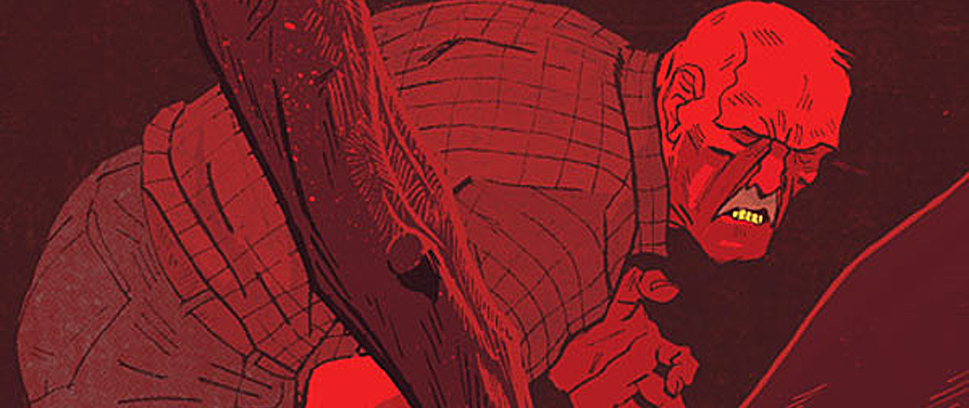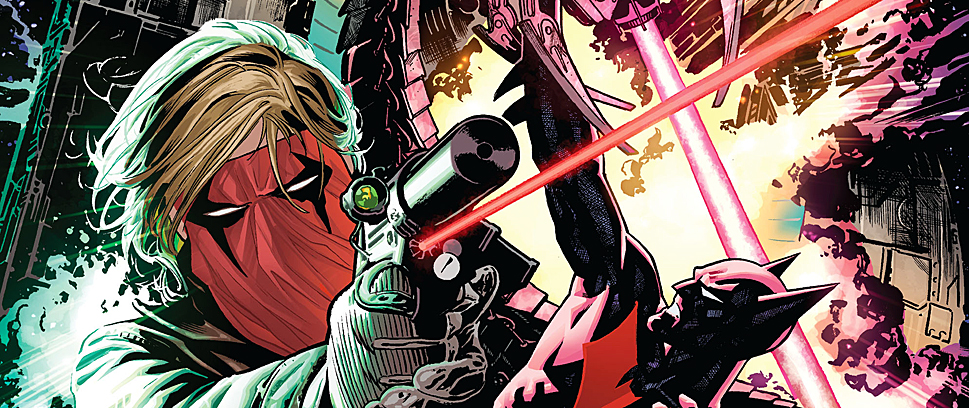
Last Week’s Comics 9/10/2014
Southern Bastards #4
(Image – writer: Jason Aaron; artist: Jason Latour)
A few months ago, Unwinnable Editor-in-Chief, Stu Horvath, ended his review of Southern Bastards #1 with, “I can’t wait to see the wreckage as the story unfolds in the coming months.”
 Well, it happened, Stu. I hope you’re happy, because the wreckage wrought in this comic is emotionally devastating.
Well, it happened, Stu. I hope you’re happy, because the wreckage wrought in this comic is emotionally devastating.
Southern Bastards #4 marks the end of the series’ first arc, “Here Was a Man.”
Craw County got on without Earl Tubbs for 40 years. Then he came back. Earl saw some wrongs that needed righting. He tried to stay out of it at first, like so many rogue heroes do, but he was drawn back in when an old buddy was murdered. Earl’s father was a bastard, and now Earl had to take on Daddy’s work to make things right in Craw County.
That was the plot in issues 1-3. It’s a pretty standard setup for westerns and crime dramas. That’s what Jason Aaron and Jason Latour banked on while crafting this tale – the structure is all too familiar. Here was Earl Tubb, an old hardass with a big stick. If Craw County wasn’t going to listen to his speech about decency, he was going to beat that decency into them.
In this issue, Earl Tubb stands in the town center, appealing to Craw County’s better instincts. He tells them they don’t have to stand by and take the abuse Esaw and his goons dish out. He calls the crowd church-goin’ people. They went to church all right – on Palm Sunday at least. One whips a stone at Earl while they all chant for him to go back to Birmingham. And that’s when Jason Latour’s art shines.
Earl fights his way through. Latour lays down a massive two-page spread showing the whole of Earl’s life intercut with him battling Esaw and the rest of Coach Boss’ thugs. Images of Earl’s dead Vietnam CO, a woman he’s having sex with and his mean old pa are all intercut with Earl’s knock-down, drag-out fight in the street. His whole life flashes before the audience as he wins the battle and marches into the diner to win the war.
And there sits Coach Boss, sucking on dry rib bones, mocking Earl.
Thing is, while Earl is a product of Craw County, he left there 40 years prior, and that long absence blinded him to the truth. He’d been so far away from all the football, barbecue and violence that he underestimated Coach Boss and his cronies. Craw County hadn’t changed – Earl did. His mistake proved mighty fatal.
The image of Earl provoking Coach Boss into attacking him takes a heartbreaking turn. This is the story of the hero, I instinctively felt as I read those last few pages, Earl’s gotta take down Coach Boss. And that was EXACTLY when Aaron and Latour punch the reader in the gut. As a victorious Coach Boss walked away from Earl’s mangled corpse, a lump rose in my throat, followed by a realization: this book is called Southern Bastards for a fucking reason.
Still, Aaron and Latour haven’t closed the book on the Tubb family. They reveal just who Earl had been leaving messages for in the last four issues: his U.S. Marine of a daughter. When she finds out why her father will never be able to call her back, I reckon this young woman is going to raise some hell in the backwoods.
———
Spider-Man 2099 #3
 (Marvel – writer: Peter David; artist: Will Sliney)
(Marvel – writer: Peter David; artist: Will Sliney)
Spider-Man 2099 is just a fun comic to read. I was pleasantly surprised by the first two issues and the way Peter David handled Miguel O’Hara’s transition into the current Spider-verse. The comic showed a nice mix of humor and story, building for the future of the series while keeping away from the initial dourness of the first Spider-Man 2099 run.
This issue, however, lacks the usual buoyancy, and while still entertaining, it falls a bit flat in its heavy-handed theme of the military industrial complex and its effect on the innocent civilians of impoverished
nations.
Spider-Slayers act as the MacGuffin in this issue, as Tiberius Stone runs afoul of a group of bandits who mean to stop him from selling weapons to a warlord known as Jalfaha Dahn, a man who plans to use the Spider-Slayers to keep his countrymen from rebelling anymore. Miguel’s problem is that he’s been blackmailed into going along with Stone since he somewhat revealed his true identity to Liz Allen. And taking a page from Back to the Future’s book, if Miguel allows Tiberius to die, he, too, will disappear.
Added to the mix is the moral conundrum of using weapons to save lives, but none of these pieces feels original. They definitely add to the conflict, and Miguel certainly has his work cut out for him by the end of the issue, but these plot points lack the originality David established in the previous issues. We’ve tread over this ground before. The moral weight of the comic drags down the story a bit, and as a result, the pacing falls a bit flat.
The grim nature of the storytelling also means that Will Sliney and Antonio Fabela have to respond in kind, and as such, the comic is very muted. The positive, though, is that some colors – like those of Miguel’s costume – pop off the page. The imagery is sharp and gets clearer as the issue progresses, closing with a great close-up of Spider-Man 2099.
The issue isn’t bad, just not as entertaining as the first two. The content is definitely topical, as much of what David covers in the issue is a mask for what the United States is currently doing in certain areas around the world. While I think comics are a great forum to debate the merits of such decisions, the execution is overbearing and preachy.
I’m still digging the series, but this issue just didn’t hit the same notes as the previous ones.
———
The Names #1
 (Vertigo – writer: Peter Milligan; artist: Leandro Fernandez)
(Vertigo – writer: Peter Milligan; artist: Leandro Fernandez)
In the first two pages, Peter Milligan’s new comic, The Names, establishes itself as brutal, enigmatic and wholly entertaining. Opening with a harrowing confrontation between a Wall Street trader and a man only known as the Surgeon, The Names hits the gas and never lets up.
The story follows Katya Walker, a woman whose husband’s recent suicide raises a series of questions that lead her to the discovery that her husband was murdered – but the why is still a mystery. Milligan builds a world around Katya’s husband, Kevin, but in a way that slowly reveals layers of his life. Each of these layers is more engaging than the next, so that by the end of the issue, Milligan has us completely hooked on the mystery.
Furthermore, Milligan’s lead – the strong and ferocious Katya – proves herself to be more than just the wife of a rich investment banker. Over the course of the issue, she transforms from the grieving widow into the vengeful heroine, and one who will get her revenge.
Thrown into the mix are Dark Loops, sentient creations that are waging their own war on the world, but on a technological level that has yet to be fully revealed. However, given what Milligan has shown us so far, I think we’re in for a pretty terrifying enemy.
Leandro Fernandez reminds me of a cleaner Jeff Lemire. His work has the same gritty look, but some of it takes a page from Frank Miller’s Sin City, particularly in the climax where Katya confronts her husband’s partner, Marco. Everything Miller builds towards comes to a head in this section, and Fernandez complies by providing striking visuals to go along with the solid storytelling.
What can I say except buy The Names. It’s equal parts espionage, thriller and mystery with all pieces playing together in a superb chorus of storytelling. From beginning to end, The Names will suck you in.
I think you’ll be happy to take the ride.
———
 Detective Comics One-Shot #1
Detective Comics One-Shot #1
(DC- writer: Brian Buccellato; artist: Scott Hepburn, Cliff Richards and Fabrizio Fiorentino)
I went into this issue with high hopes, on a total misunderstanding. I approach most things, (art, music, writing) with low expectations. If something is good, it seems all the more better from my starting point.
It’s five years from “now” and the future is bleak. It’s “Futures End,” DC’s current universe-wide event, and this month every title is taking a timeout to jump forward. Gotham is in the worst way, and Calendar Man is the criminal kingpin. Things are so bad that Batman has to enlist the Riddler’s help. I think to myself, “I like how DC is making things so tight that Batman’s career proper is only five years, because it’s five years after Zero Year, right?”
And then, on the last page, Calendar Man tells Riddler that he’s been waiting 11 years to take vengeance on the person responsible for his wife’s death during Gotham’s blackout.
Well, I was never good at math, but if that’s the dumbest thing I’ve done all week, then I’m okay. I’ll take 11 years just as happily as I was going to take five.
I’m satisfied with this issue overall. I like the mystery it comes from and the mystery it leaves on (is Batman okay with potentially sending Riddler to his death?) It almost makes me want to read the entire “Future’s End” story, but I’m not going to buy the zillion weekly issues and miscellaneous tie-ins. I may eventually buy the collection, but more likely I’ll wait for my local library to get it (my town is blessed with a public library with a fantastic graphic novel selection, goodies that are old, new and in between.)
I do need to point out/complain that DC is playing on us comic book nerds’ inherent collector impulses by spreading a story as thin and wide as is being done with “Futures End.” Not only do I have to buy each monthly issue of Detective Comics, but I just had to buy Annual #3 and now another tie-in? Detective Comics One-Shot could just as easily been this year’s Annual, although I really did like Annual #3 and how it recreates Calendar Man in the New 52.
The three-artist attack of this issue is both interesting and a little disorienting (Batman’s mask inexplicably grows a chin strap mid venture.) All three artists have their individual styles, enjoyable on their own, but I prefer the consistency of one artist per book.
I can look at things like this: I have my own “Futures End” adventure in the coming weeks. Where will I be at the end of September? How many extra books will DC make me buy? Is my future written? Stay tuned!
———
Black Widow #10
 (Marvel – writer: Nathan Edmondson; artist: Phil Noto)
(Marvel – writer: Nathan Edmondson; artist: Phil Noto)
Reading Black Widow #10 is like watching an old black-and-white movie. Except this time, the femme fatale is the star.
Last issue, Black Widow’s mysterious new enemy kidnapped her attorney, Isaiah. Now, we learn that the new enemy was actually an old ally named Rashid. Most of Black Widow #10 is devoted to a flashback of Black Widow’s mission to extract Rashid from Pakistan – a mission that pitted her directly against Clint Barton, a.k.a. Hawkeye.
Hawkeye first dropped into Black Widow – literally – in issue #6, and a friend and I loved the way artist Phil Noto drew him so much that we quickly dubbed him Sexy Noto Hawkeye. Now Sexy Noto Hawkeye is back, but unlike the other guest stars who appeared in Black Widow #8 and 9, Hawkeye appears only in the flashbacks, not in Black Widow’s present.
I would have liked to see more of Natasha and Clint’s present relationship, but the issue’s opening text suggests that this flashback mission takes place during the period in Avengers history after Hawkeye had renounced his criminal past and joined the Avengers – but before Black Widow had left the KGB to do the same. It’s an interesting period in both characters’ lives, both independently and as a short-lived romantic couple, but it’s one we rarely see discussed in modern comics, because these events were being written in the comic books of the late ’60s and early ’70s.
Writer Nathan Edmondson keeps the dialogue to a minimum, letting Noto’s expressive, dynamic art carry the book as Natasha and Clint clash on the streets and rooftops of Pakistan – Natasha trying to get Rashid out of the city, Clint trying to bring him in. Sexy Noto Hawkeye has a sort of Humphrey Bogart quality to his face that fits perfectly in the sepia-colored backdrop and the film-like quality of the action played out across the panels.
Black Widow #10 is a well-executed introduction to our femme fatale’s new villain that also gives the creators a chance to show readers a bit of Natasha’s past jobs and her complicated relationships. Unfortunately for Isaiah, the issue spends so much time in the past that Natasha hasn’t even had a chance to start rescuing him. That’ll have to wait until next time.
———
The Death-Defying Doctor Mirage #1
 (Valiant – writer: Jen Van Meter; artist: Roberto de la Torre)
(Valiant – writer: Jen Van Meter; artist: Roberto de la Torre)
Shan Fong, professional name Doctor Mirage, can speak to dead people – all except her own deceased husband. So her latest job, helping a group of widows speak to their deceased spouses, hits a little too close to home.
That’s the opening scene of The Death-Defying Doctor Mirage #1, an all-new comic book from writer Jen Van Meter (Hopeless Savages, Black Cat) and artist Roberto de la Torre (Ms. Marvel vol. 2, Iron Man vol. 4). And honestly I teared up about two pages in. Now, people talking to their dead loved ones is always an instant tearjerker for me, but that’s not to say the scene wasn’t particularly well-done; it conveyed the women’s grief without being ham-fisted. The scene also doubled as an effective introduction to Shan’s abilities, as well as her personal struggles with her husband’s death.
After finishing with the widows (and telling her manager that if he ever sets her up on a similar gig, she’ll fire him), it’s on to the next job, one that starts off looking like a cake walk: a former military contractor and reclusive billionaire named Linton March wants to hire Mirage, and he’s willing to pay handsomely.
But March doesn’t want Mirage to help him speak to his dead wife, as she originally assumed; after a long but fascinating few panels of small talk March reveals his true dilemma, one much more dangerous than Mirage originally believed.
The art of The Death-Defying Doctor Mirage combines a traditional black line-heavy comic book style with some degree of expressionism, particularly in the characters’ lined faces and hunched, emotional bodies. Frequently, the black lines are so thick they become shading, creating large black spaces that give the panels weight and a sense of ominous foreboding. Between the lines de la Torre uses solid colors, often casting whole pages in a single unified color scheme.
The conversations in the issue reveal a world where magic is science and paranormal is normal. We learn that magic is common, but it has rules, and only experts like Mirage can hope to safely handle it.
Some of Mirage’s dialogue feels awkward, but it’s the stubborn, melancholy awkwardness of a person who dislikes other people and takes a bitter enjoyment from letting them know it. I like Shan’s prickly, rude attitude, but I also want to see more of her character beyond this gruff facade she presents to her clients.
Like its titular heroine, The Death-Defying Doctor Mirage is dark, strange, brusque and somehow still subtly fascinating. Here’s another book I’ll be adding to my monthly pull list.




